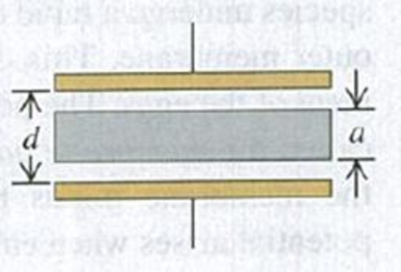
Concept explainers
An air capacitor is made by using two flat plates, each with area A, separated by a distance d. Then a metal slab having thickness a (less than d) and the same shape and size as the plates is inserted between them, parallel to the plates and not touching either plate (Fig. P24.62). (a) What is the capacitance of this arrangement? (b) Express the capacitance as a multiple of the capacitance C0 when the metal slab is not present, (c) Discuss what happens to the capacitance in the limits a → 0 and a → d.
Figure P24.62

Learn your wayIncludes step-by-step video

Chapter 24 Solutions
University Physics with Modern Physics Plus Mastering Physics with eText -- Access Card Package (14th Edition)
Additional Science Textbook Solutions
Introduction to Electrodynamics
Life in the Universe (4th Edition)
Physics for Scientists and Engineers with Modern Physics
University Physics Volume 1
- The separation between the 4.40-cm2 plates of an air-filled parallel-plate capacitor is 0.230 cm. a. What is the capacitance of this capacitor? If the capacitor is connected to a 9.00-V battery, find b. the charge stored by the capacitor and c. the magnitude of the electric field between its plates.arrow_forwardA parallel-plate capacitor has square plates of side s = 2.50 cm and plate separation d = 2.50 mm. The capacitor is charged by a battery to a charge Q = 4.00 C, after which the battery is disconnected. A porcelain dielectric ( = 6.5) is then inserted a distance y = 1.00 cm into the capacitor (Fig. P27.88). Hint: Consider the system as two capacitors connected in parallel. a. What is the effective capacitance of this capacitor? b. How much energy is stored in the capacitor? c. What are the magnitude and direction of the force exerted on the dielectric by the plates of the capacitor? Figure P27.88arrow_forwardAn arrangement of capacitors is shown in Figure P27.23. a. If C = 9.70 105 F, what is the equivalent capacitance between points a and b? b. A battery with a potential difference of 12.00 V is connected to a capacitor with the equivalent capacitance. What is the energy stored by this capacitor? Figure P27.23 Problems 23 and 24.arrow_forward
- An electronics technician wishes to construct a parallel plate capacitor using rutile ( = 100) as the dielectric. The area of the plates is 1.00 cm2. What is the capacitance if the rutile thickness is 1.00 mm? (a) 88.5 pF (b) 177 pF (c) 8.85 F (d) 100 F (e) 35.4 Farrow_forwardBy what factor is the capacitance of a metal sphere multiplied if its volume is tripled? (a) 3 (b) 31/3 (c) 1 (d) 31/3 (e) 13arrow_forwardA spherical capacitor consists of a spherical conducting shell of radius b and charge 2Q that is concentric with a smaller conducting sphere of radius a and charge +Q (Fig. P20.36). (a) Show that its capacitance is C=abke(ba) (b) Show that as b approaches infinity, the capacitance approaches the value a/ke = 40a. Figure P20.36arrow_forward
- A charged particle is moved in a uniform electric field between two points, A and B, as depicted in Figure P26.65. Does the change in the electric potential or the change in the electric potential energy of the particle depend on the sign of the charged particle? Consider the movement of the particle from A to B, and vice versa, and determine the signs of the electric potential and the electric potential energy in each possible scenario.arrow_forwardA 56.90-pF cylindrical capacitor carries a charge of 1.540 C. The capacitor has a length of 1.000 103 m. a. What is the potential difference across the capacitor? b. If the radial separation between the two cylinders is 6.520 104 m, what are the inner and outer radii of the cylindrical conductors?arrow_forwardFIGURE P26.14 Problems 14, 15, and 16. Four charged particles are at rest at the corners of a square (Fig. P26.14). The net charges are q1 = q2 = 2.65 C and q3 = q4 = 5.15 C. The distance between particle 1 and particle 3 is r13 = 1.75 cm. a. What is the electric potential energy of the four-particle system? b. If the particles are released from rest, what will happen to the system? In particular, what will happen to the systems kinetic energy as their separations become infinite?arrow_forward
- A parallel-plate capacitor with an air gap has capacitance C0. It is connected to a battery with potential V0 that gives it charge Q0 and stored energy U0. After the capacitor is disconnected from the battery, a dielectric with constant = 3 is inserted into the air gap, completely filling it. In terms of the initial values, find the new capacitance C, charge Q, potential V, and stored energy U.arrow_forwardA spherical capacitor is made up of two concentric spherical conductors. The inner sphere has positive charge +Q, and the outer sphere has negative charge Q. The radius of the inner sphere is rin, and the radius of the outer sphere is rout. Show that its capacitance is C = 40[rinrout/(rout rin)].arrow_forwardGiven the arrangement of capacitors in Figure P27.23, find an expression for the equivalent capacitance between points a and b. Figure P27.23 Problems 23 and 24.arrow_forward
 College PhysicsPhysicsISBN:9781305952300Author:Raymond A. Serway, Chris VuillePublisher:Cengage Learning
College PhysicsPhysicsISBN:9781305952300Author:Raymond A. Serway, Chris VuillePublisher:Cengage Learning Physics for Scientists and Engineers with Modern ...PhysicsISBN:9781337553292Author:Raymond A. Serway, John W. JewettPublisher:Cengage Learning
Physics for Scientists and Engineers with Modern ...PhysicsISBN:9781337553292Author:Raymond A. Serway, John W. JewettPublisher:Cengage Learning Principles of Physics: A Calculus-Based TextPhysicsISBN:9781133104261Author:Raymond A. Serway, John W. JewettPublisher:Cengage Learning
Principles of Physics: A Calculus-Based TextPhysicsISBN:9781133104261Author:Raymond A. Serway, John W. JewettPublisher:Cengage Learning College PhysicsPhysicsISBN:9781285737027Author:Raymond A. Serway, Chris VuillePublisher:Cengage Learning
College PhysicsPhysicsISBN:9781285737027Author:Raymond A. Serway, Chris VuillePublisher:Cengage Learning
 Physics for Scientists and Engineers: Foundations...PhysicsISBN:9781133939146Author:Katz, Debora M.Publisher:Cengage Learning
Physics for Scientists and Engineers: Foundations...PhysicsISBN:9781133939146Author:Katz, Debora M.Publisher:Cengage Learning





